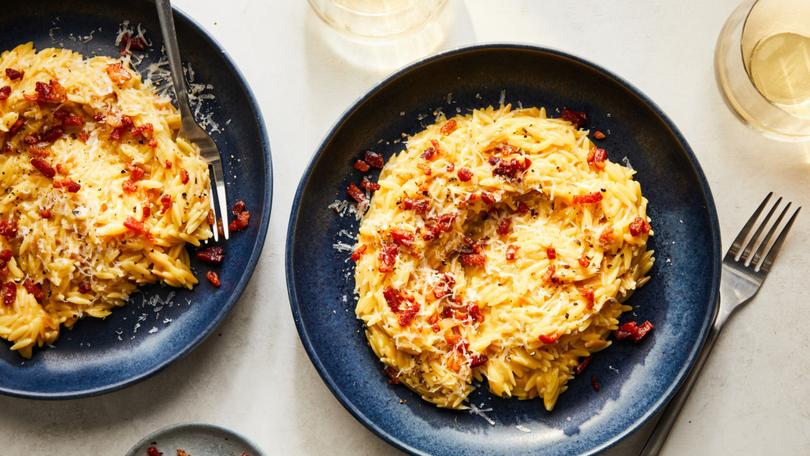The New York Times: A Fast, Foolproof Carbonara for Orzo Lovers

The Italian carbonara police don’t want you to put ham in your spaghetti carbonara; they’ve made that clear. And don’t even think about splashing in cream or grating over Parmesan instead of pecorino.
But would they be so angry if the noodles were another shape — maybe small, ovalish orzo?
Carbonara “is the poster child for everything that’s wrong and right with trends,” said Roberto Serrini, a filmmaker and journalist who has studied carbonara intensely. His main point is that carbonara changes with time.
Sign up to The Nightly's newsletters.
Get the first look at the digital newspaper, curated daily stories and breaking headlines delivered to your inbox.
By continuing you agree to our Terms and Privacy Policy.In the 1960s, it meant a splash of Cognac to pair with the bacon. Today, it means guanciale, eggs, Pecorino Romano and lots of black pepper (the carbon in carbonara).
One thing is clear: Using orzo pasta gets you to a plate of creamy, cheesy carbohydrates in a faster, and more foolproof, way than rice or spaghetti alike.
This is carbonara for the clumsy, the impatient and the greedy.
In Italy, the dish known as orzotto — a portmanteau of the words orzo and risotto — is made with pearl barley, “orzo” in Italian. Outside the country, however, and as it is here, the same word can refer to a risotto-like dish where orzo pasta, what Italians call “risoni” (large rice), is used in place of the rice.
Orzotto is “better than risotto because it’s a little easier to cook,” Serrini said. “You don’t have to stir it constantly.”
In this recipe, the chicken stock is added all at once, and the orzo needs a mere 7 to 9 minutes to plump over a gentle flame. You can take comfort in knowing that your result will eat like a risotto in half the time and with much less stirring — and your mouth will be coated with carbonara’s perfect emulsion of cheese, egg and pork fat.
The anchoring succor of a classic carbonara cannot be beat, but it takes some technique to get the texture right. The trick here is to use guanciale, cured pork jowl, if you can find it, not just for its peppery flavor and crispy meat, but for its golden fat, which helps blend the eggs into a smooth sauce.
And the eggs, run through with pecorino and a cascade of freshly ground black pepper, should be first tempered with a ladle of the cooked orzo before folding into the rest of the pot. The extra starchiness of the rice-shaped pasta is yet even more insurance against the worst thing that can happen to your carbonara: scrambled eggs.
This is carbonara for the clumsy, the impatient and the greedy.
For more of a risotto flavor (at the risk of angering purists), you could cook a finely diced shallot, maybe even some celery or celery seed, in the guanciale fat before adding the orzo, then stir in a splash of white wine or Cognac.
This eggy-peppery comfort is best eaten right off the heat. But it is odd how, even straight out of the fridge, cold, it still stays glossy, like a dreamy pasta salad.
The carbonara police might not like that, but you do, right?
Recipe: Orzotto Alla Carbonara
By Eric Kim
Yield: 2 to 4 servings
Total time: 35 minutes
Ingredients:
3 1/2 ounces guanciale, pancetta or thick-cut bacon, cut into small dice (2/3 cup)
1 1/4 cups/about 9 ounces dry orzo
Salt and freshly ground black pepper
3 cups low-sodium chicken broth, plus more as needed
6 tablespoons finely grated Pecorino Romano or Parmesan, plus more for serving
1 large egg plus 2 egg yolks
Preparation:
1. Add the guanciale to a large, high-sided skillet and set over medium heat. Cook, stirring occasionally, until deeply browned and crispy all over, about 5 minutes. Using a slotted spoon, transfer the guanciale to a small dish. Drain off all but 2 tablespoons of the fat from the skillet; reserve the extra fat for another use.
2. Stir the orzo into the fat in the skillet until coated, then season with salt and pepper. Stir constantly for just a few seconds, then add the chicken broth, raise the heat to high and bring to a simmer. Reduce the heat to medium-low to maintain a gentle simmer. Cook, stirring occasionally so the orzo doesn’t stick to the bottom of the skillet, until the orzo is tender and loose like risotto, adding more broth as needed, 7 to 9 minutes. At this point, the pasta should have absorbed most of the liquid.
3. Take the skillet off the heat and vigorously stir in 4 tablespoons of the pecorino. In a small bowl, whisk together the egg and yolks. Stir in the remaining 2 tablespoons pecorino and 1/4 cup of the orzo to temper the eggs and prevent them from scrambling when added to the skillet. Stir this mixture into the hot orzo, then immediately shake the skillet with one hand and stir with the other until the orzo is creamy and thick, about 1 minute.
4. Taste and add salt as desired. Divide among plates and sprinkle with more pecorino, black pepper and the reserved guanciale.
This article originally appeared in The New York Times.
© 2023 The New York Times Company
Originally published on The New York Times
